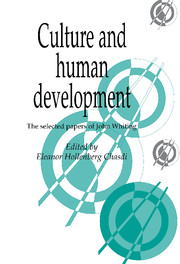Book contents
- Frontmatter
- Contents
- List of figures
- Preface
- Acknowledgments
- Introduction: John Whiting and anthropology
- Fifty years as a behavioral scientist: autobiographical notes
- Part I Theory and methods
- Part II Environment and history
- Part III Moral development
- Part IV Gender development
- Part V Development of social behavior
- Introduction
- 11 Altruistic and egoistic behavior in six cultures
- 12 The duration of maidenhood across cultures
- 13 Social change in adolescent sexual behavior, mate selection, and premarital pregnancy rates in a Kikuyu community
- Bibliography
- Complete bibliography of John W. M. Whiting's work
- Index
11 - Altruistic and egoistic behavior in six cultures
Published online by Cambridge University Press: 23 December 2009
- Frontmatter
- Contents
- List of figures
- Preface
- Acknowledgments
- Introduction: John Whiting and anthropology
- Fifty years as a behavioral scientist: autobiographical notes
- Part I Theory and methods
- Part II Environment and history
- Part III Moral development
- Part IV Gender development
- Part V Development of social behavior
- Introduction
- 11 Altruistic and egoistic behavior in six cultures
- 12 The duration of maidenhood across cultures
- 13 Social change in adolescent sexual behavior, mate selection, and premarital pregnancy rates in a Kikuyu community
- Bibliography
- Complete bibliography of John W. M. Whiting's work
- Index
Summary
Most systematic observation of children's social behavior has been done on American and British children. Our knowledge of the behavior of children in other cultures is based largely upon ethnographic reports in which general statements are made describing the customary or typical behavior of the children of the society being studied. Although these reports have been very useful in broadening our culture-bound perspective, it became evident that more detailed and systematic observations were needed to determine which of the findings reported in the child development research literature were unique to modern Western industrial societies, and which were transculturally valid.
William Lambert, Irvin Child, and the present authors undertook to make a start on this task in the early 1950s. A corpus of detailed materials was collected on the social behavior of a sample of children in six communities, each representing a different culture. The field teams who collected these data were: Robert and Barbara LeVine, Nyansongo, a Gusii community in Kenya; Kimball and Romaine Romney, Juxtlahuaca, a Mixtecan barrio in Mexico; William and Corrine Nydegger, Tarong, a hamlet in northern Luzon, Philippines; Thomas and Hatsumi Maretzki, Taira, a Ryukyuan village in Okinawa; Leigh Minturn and John Hitchcock, Khalapur, a local segment of a Rajput caste group in Uttar Pradesh, India; John and Anne Fisher, Orchard Town, a subcommunity of Yankees in a New England town, USA.
In addition to collecting materials on the culture of each community, the field teams, assisted by a bilingual member of each society, collected descriptive protocols on the social interaction of children in natural settings. The samples of children from each community were matched by sex and age groups.
- Type
- Chapter
- Information
- Culture and Human DevelopmentThe Selected Papers of John Whiting, pp. 267 - 281Publisher: Cambridge University PressPrint publication year: 1993



